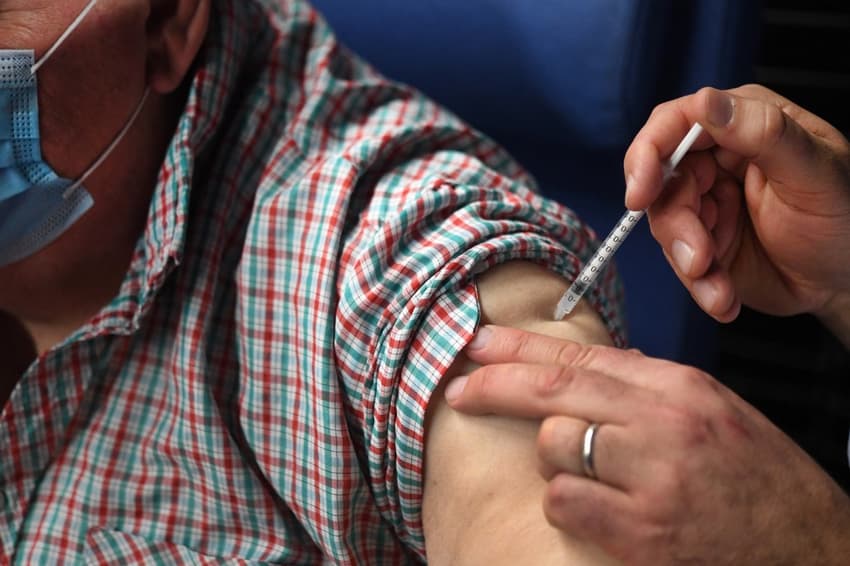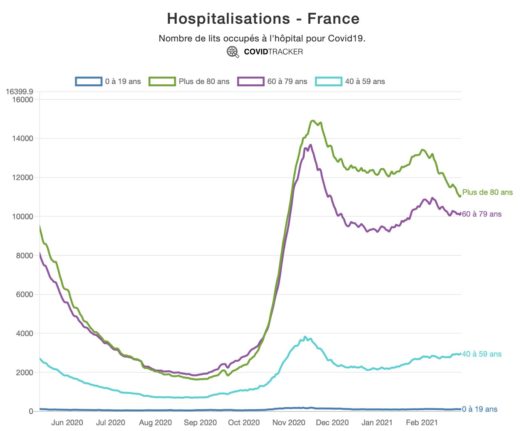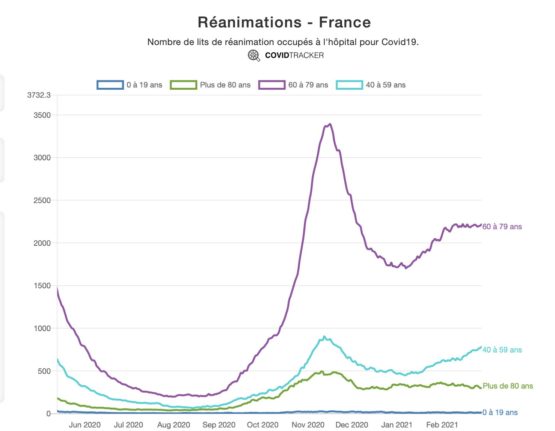IN NUMBERS: Is France's Covid death rate already seeing a 'vaccine effect'?

France's vaccine rollout has been the subject of widespread criticism for its sluggish pace, but ministers claim that the decision to prioritise the most vulnerable has been vindicated in reduced death rates in certain groups. These are the latest statistics on deaths, hospitalisations and cases.
Cases
Overall, cases in France remain on the 'high plateau' that has been seen since December with roughly 20,000 new cases per day.
However after falling in mid February, cases are now on the rise and the overall figure hides sharp regional variation.
Twenty départements have been placed on 'alert' for extra restrictions because of their worryingly high case numbers, with the number of cases per 100,000 people in the northern port town of Dunkirk more than 900 (against a national average of 220).
Les Alpes-de-Haute-Provence dépassent désormais le seuil d’alerte maximale (250) https://t.co/OlXJxDKk1C pic.twitter.com/hVJ8SvoZUa
— GRZ (@GuillaumeRozier) March 1, 2021
The graph below shows the rise in the percentage of tests coming back positive, which is sharply increasing in several areas, with the Paris area département of Seine-Saint-Denis showing a particularly steep rise.
L’évolution du taux de positivité dans les départements que je surveille le plus me paraît un peu plus rassurante aujourd’hui. Hausse moins forte dans le 93, 62, 91... https://t.co/xGu1LkQmaQ pic.twitter.com/WdiqwbedVn
— GRZ (@GuillaumeRozier) March 1, 2021
Hospitals
Hospitals in areas of France with high case numbers are struggling to cope, with hospitals in Nice having to transfer some of the most seriously ill patients to other areas.
On a national level intensive care occupancy remains high at 70.1 percent, while several of the 20 'alert' départements are recording occupancy of above 100 percent of their usual capacity. Across the country 3,544 Covid patients were in intensive care on March 1st.
IN DETAIL Why 20 areas of France face extra restrictions and why?
However, there is cause for some hope, as the total number of hospitalisations in France have begun to fall, particularly in the over 80s category, as this graph from French data scientist Guillaume Rozier of the CovidTracker website shows.

Graphic: CovidTracker
Throughout the pandemic, the over 60s have represented the great majority of Covid cases hospitalised as they are much more prone to developing the most serious forms of the disease.
Although overall hospital numbers remain high, hospitalisation rates in both the 60-79 age group and the over 80s have seen a sharp decline since the beginning of February, as the vaccination programme began to be rolled out.
Hospitalisation rates among the 40-59 age group, who are generally not eligible for the vaccine yet, have seen no change over the last month.
Speaking on February 25th, Health Minister Olivier Véran said: "The average age of patients admitted to hospital and of patients with severe forms in the emergency room or intensive care unit [...] is falling by an average of 6 or 7 years, ie patients in intensive care seem to be moving towards an average age of around 55 (from 63 previously).
"It doesn't mean that the virus is more serious in young people, it means that there are fewer very old people who are sick because of the vaccination and the fact that they are protected.
"This means that we can hope [...] that for every 100 vaccines given, there will be proportionally fewer serious forms of the virus than before."
The picture related to Covid patients sick enough to need to an intensive care bed is less clear.

Graphic: CovidTracker
Here the 60-79-year-old patients make up the largest group. Admissions to intensive care among this group had been rising steadily since January, reflecting an overall trend of increased ICU occupancy which has risen from 50 percent at the start of the year to 69 percent now.
However from February the rise in new admissions from 60-79-year-olds has stopped and the rate has been on a plateau for the last three weeks.
Intensive care occupancy is watched closely by health experts because it is a key indicator both of whether the health service is coping and the likely death tolls in the days to come.
Deaths
Daily death rates in France remain high, and higher than many of its neighbours, showing that the virus is still circulating at an elevated level.
On March 1st, 379 deaths were reported in the previous 24 hours, although Monday figures are often high due to under-reporting over the weekend. But daily figures have been above 200 for many weeks.
However looking solely at deaths in Ehpad nursing homes, these have seen a very noticeable drop since late February, from a plateau of between 120 and 130 deaths a week in late January/early February to 72 in the week beginning February 25th.
Du coup, on peut aussi mettre ce nombre en relief avec les taux de couverture vaccinale, même s'il est sans doute un peu trop tôt pour affirmer que corrélation vaut causalité.
8/10 pic.twitter.com/jV7PVUb9Ka
— Nicolas Berrod (@nicolasberrod) March 1, 2021
This takes place as vaccine rates climb to 82 percent of residents having received their first vaccine and 50 percent fully vaccinated.
While France's vaccine rollout has undoubtedly been very slow and cumbersome it has also been sharply targeted on the most vulnerable people, with residents of Ehpads the first to get their vaccines, ahead of healthcare workers and over 75s living in the community.
READ ALSO Unanswered phones and long waits - the frustrations of getting a Covid vaccine in France
The reasoning behind this was that Ehpad residents are the most fragile in society, frequently with multiple medical conditions as well as being elderly and the country's Ehpads saw terrible death tolls in the early days of the pandemic. Overall roughly one third of all Covid deaths have occurred in Ehpads.
Vaccine numbers
France's vaccine progress remains slow in comparison to its neighbours, as of February 27th, 2.9 million injections had been given, with 1.5 million people receiving both doses and therefore being fully vaccinated.
That represents less than five percent of the population, so the fact that an effect is noticeable in some groups bodes well for a more dramatic effect once more people are vaccinated.
From March 2nd, 50-74-year-olds with underlying health conditions are eligible to be vaccinated by their GP, while the green light has been given for the rollout of vaccinations in pharmacies, which will hopefully speed up the programme.
The government's target is to have offered the vaccine to everyone who wants it by August.
Comments (1)
See Also
Cases
Overall, cases in France remain on the 'high plateau' that has been seen since December with roughly 20,000 new cases per day.
However after falling in mid February, cases are now on the rise and the overall figure hides sharp regional variation.
Twenty départements have been placed on 'alert' for extra restrictions because of their worryingly high case numbers, with the number of cases per 100,000 people in the northern port town of Dunkirk more than 900 (against a national average of 220).
Les Alpes-de-Haute-Provence dépassent désormais le seuil d’alerte maximale (250) https://t.co/OlXJxDKk1C pic.twitter.com/hVJ8SvoZUa
— GRZ (@GuillaumeRozier) March 1, 2021
The graph below shows the rise in the percentage of tests coming back positive, which is sharply increasing in several areas, with the Paris area département of Seine-Saint-Denis showing a particularly steep rise.
L’évolution du taux de positivité dans les départements que je surveille le plus me paraît un peu plus rassurante aujourd’hui. Hausse moins forte dans le 93, 62, 91... https://t.co/xGu1LkQmaQ pic.twitter.com/WdiqwbedVn
— GRZ (@GuillaumeRozier) March 1, 2021
Hospitals
Hospitals in areas of France with high case numbers are struggling to cope, with hospitals in Nice having to transfer some of the most seriously ill patients to other areas.
On a national level intensive care occupancy remains high at 70.1 percent, while several of the 20 'alert' départements are recording occupancy of above 100 percent of their usual capacity. Across the country 3,544 Covid patients were in intensive care on March 1st.
IN DETAIL Why 20 areas of France face extra restrictions and why?
However, there is cause for some hope, as the total number of hospitalisations in France have begun to fall, particularly in the over 80s category, as this graph from French data scientist Guillaume Rozier of the CovidTracker website shows.

Graphic: CovidTracker
Throughout the pandemic, the over 60s have represented the great majority of Covid cases hospitalised as they are much more prone to developing the most serious forms of the disease.
Although overall hospital numbers remain high, hospitalisation rates in both the 60-79 age group and the over 80s have seen a sharp decline since the beginning of February, as the vaccination programme began to be rolled out.
Hospitalisation rates among the 40-59 age group, who are generally not eligible for the vaccine yet, have seen no change over the last month.
Speaking on February 25th, Health Minister Olivier Véran said: "The average age of patients admitted to hospital and of patients with severe forms in the emergency room or intensive care unit [...] is falling by an average of 6 or 7 years, ie patients in intensive care seem to be moving towards an average age of around 55 (from 63 previously).
"It doesn't mean that the virus is more serious in young people, it means that there are fewer very old people who are sick because of the vaccination and the fact that they are protected.
"This means that we can hope [...] that for every 100 vaccines given, there will be proportionally fewer serious forms of the virus than before."
The picture related to Covid patients sick enough to need to an intensive care bed is less clear.

Graphic: CovidTracker
Here the 60-79-year-old patients make up the largest group. Admissions to intensive care among this group had been rising steadily since January, reflecting an overall trend of increased ICU occupancy which has risen from 50 percent at the start of the year to 69 percent now.
However from February the rise in new admissions from 60-79-year-olds has stopped and the rate has been on a plateau for the last three weeks.
Intensive care occupancy is watched closely by health experts because it is a key indicator both of whether the health service is coping and the likely death tolls in the days to come.
Deaths
Daily death rates in France remain high, and higher than many of its neighbours, showing that the virus is still circulating at an elevated level.
On March 1st, 379 deaths were reported in the previous 24 hours, although Monday figures are often high due to under-reporting over the weekend. But daily figures have been above 200 for many weeks.
However looking solely at deaths in Ehpad nursing homes, these have seen a very noticeable drop since late February, from a plateau of between 120 and 130 deaths a week in late January/early February to 72 in the week beginning February 25th.
Du coup, on peut aussi mettre ce nombre en relief avec les taux de couverture vaccinale, même s'il est sans doute un peu trop tôt pour affirmer que corrélation vaut causalité.
— Nicolas Berrod (@nicolasberrod) March 1, 2021
8/10 pic.twitter.com/jV7PVUb9Ka
This takes place as vaccine rates climb to 82 percent of residents having received their first vaccine and 50 percent fully vaccinated.
While France's vaccine rollout has undoubtedly been very slow and cumbersome it has also been sharply targeted on the most vulnerable people, with residents of Ehpads the first to get their vaccines, ahead of healthcare workers and over 75s living in the community.
READ ALSO Unanswered phones and long waits - the frustrations of getting a Covid vaccine in France
The reasoning behind this was that Ehpad residents are the most fragile in society, frequently with multiple medical conditions as well as being elderly and the country's Ehpads saw terrible death tolls in the early days of the pandemic. Overall roughly one third of all Covid deaths have occurred in Ehpads.
Vaccine numbers
France's vaccine progress remains slow in comparison to its neighbours, as of February 27th, 2.9 million injections had been given, with 1.5 million people receiving both doses and therefore being fully vaccinated.
That represents less than five percent of the population, so the fact that an effect is noticeable in some groups bodes well for a more dramatic effect once more people are vaccinated.
From March 2nd, 50-74-year-olds with underlying health conditions are eligible to be vaccinated by their GP, while the green light has been given for the rollout of vaccinations in pharmacies, which will hopefully speed up the programme.
The government's target is to have offered the vaccine to everyone who wants it by August.
Join the conversation in our comments section below. Share your own views and experience and if you have a question or suggestion for our journalists then email us at [email protected].
Please keep comments civil, constructive and on topic – and make sure to read our terms of use before getting involved.
Please log in here to leave a comment.